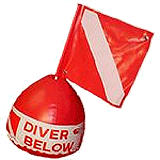
Photo from wikipedia
In this study, the methods and results of numerical simulations to estimate the motion performance of a newly developed lightweight light buoy in waves and to check the effect of… Click to show full abstract
In this study, the methods and results of numerical simulations to estimate the motion performance of a newly developed lightweight light buoy in waves and to check the effect of conceptually developed appendages on that performance were introduced. The results from a potential-based motion analysis with viscous damping coefficients obtained from free decay tests using computational fluid dynamics (CFD) and those obtained from wave motion simulation using CFD were compared. From these results, it was confirmed that viscous damping should be considered when the frequency of an incoming wave is close to the natural frequency of the buoy. It was estimated that the pitch and heave motions of the light buoy became smaller when the developed appendages were adopted. Although the quantitative superiority of the appendages was different, the qualitative superiority was similar between both results.
Journal Title: Journal of Marine Science and Engineering
Year Published: 2020
Link to full text (if available)
Share on Social Media: Sign Up to like & get
recommendations!